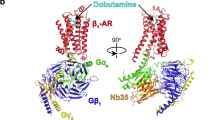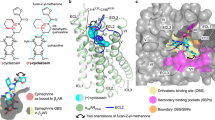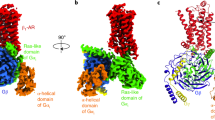Abstract
G-protein-coupled receptors have a major role in transmembrane signalling in most eukaryotes and many are important drug targets. Here we report the 2.7 Å resolution crystal structure of a β1-adrenergic receptor in complex with the high-affinity antagonist cyanopindolol. The modified turkey (Meleagris gallopavo) receptor was selected to be in its antagonist conformation and its thermostability improved by earlier limited mutagenesis. The ligand-binding pocket comprises 15 side chains from amino acid residues in 4 transmembrane α-helices and extracellular loop 2. This loop defines the entrance of the ligand-binding pocket and is stabilized by two disulphide bonds and a sodium ion. Binding of cyanopindolol to the β1-adrenergic receptor and binding of carazolol to the β2-adrenergic receptor involve similar interactions. A short well-defined helix in cytoplasmic loop 2, not observed in either rhodopsin or the β2-adrenergic receptor, directly interacts by means of a tyrosine with the highly conserved DRY motif at the end of helix 3 that is essential for receptor activation.
This is a preview of subscription content, access via your institution
Access options
Subscribe to this journal
Receive 51 print issues and online access
$199.00 per year
only $3.90 per issue
Buy this article
- Purchase on Springer Link
- Instant access to full article PDF
Prices may be subject to local taxes which are calculated during checkout




Similar content being viewed by others
References
Fredriksson, R. & Schioth, H. B. The repertoire of G-protein-coupled receptors in fully sequenced genomes. Mol. Pharmacol. 67, 1414–1425 (2005)
Hubbell, W. L., Altenbach, C., Hubbell, C. M. & Khorana, H. G. Rhodopsin structure, dynamics, and activation: a perspective from crystallography, site-directed spin labeling, sulfhydryl reactivity, and disulfide cross-linking. Adv. Protein Chem. 63, 243–290 (2003)
Altenbach, C. et al. High resolution distance mapping in rhodopsin reveals the pattern of helix movement due to activation. Proc. Natl Acad. Sci. USA 105, 7439–7444 (2008)
Foord, S. M. et al. International Union of Pharmacology. XLVI. G protein-coupled receptor list. Pharmacol. Rev. 57, 279–288 (2005)
Baldwin, J. M., Schertler, G. F. & Unger, V. M. An alpha-carbon template for the transmembrane helices in the rhodopsin family of G-protein-coupled receptors. J. Mol. Biol. 272, 144–164 (1997)
Bockaert, J. & Pin, J. P. Molecular tinkering of G protein-coupled receptors: an evolutionary success. EMBO J. 18, 1723–1729 (1999)
Ballesteros, J. A. & Weinstein, H. Integrated methods for the construction of three dimensional models and computational probing of structure function relations in G protein-coupled receptors. Methods Neurosci. 25, 366–428 (1995)
Black, J. W. Drugs from emasculated hormones — the principle of syntopic antagonism (Nobel lecture). Angew. Chem. Int. Edn Engl. 28, 886–894 (1989)
Rasmussen, S. G. et al. Crystal structure of the human β2 adrenergic G-protein-coupled receptor. Nature 450, 383–387 (2007)
Cherezov, V. et al. High-resolution crystal structure of an engineered human β2-adrenergic G protein-coupled receptor. Science 318, 1258–1265 (2007)
Baker, J. G. The selectivity of β-adrenoceptor antagonists at the human β1, β2 and β3 adrenoceptors. Br. J. Pharmacol. 144, 317–322 (2005)
Sugimoto, Y. et al. β1-selective agonist (-)-1-(3,4-dimethoxyphenetylamino)-3-(3,4-dihydroxy)-2-propanol [(-)-RO363] differentially interacts with key amino acids responsible for β1-selective binding in resting and active states. J. Pharmacol. Exp. Ther. 301, 51–58 (2002)
Gether, U. et al. Structural instability of a constitutively active G protein-coupled receptor. Agonist-independent activation due to conformational flexibility. J. Biol. Chem. 272, 2587–2590 (1997)
Parker, E. M., Kameyama, K., Higashijima, T. & Ross, E. M. Reconstitutively active G protein-coupled receptors purified from baculovirus-infected insect cells. J. Biol. Chem. 266, 519–527 (1991)
Serrano-Vega, M. J., Magnani, F., Shibata, Y. & Tate, C. G. Conformational thermostabilization of the beta1-adrenergic receptor in a detergent-resistant form. Proc. Natl Acad. Sci. USA 105, 877–882 (2008)
Baker, J. G. Site of action of β-ligands at the human β1-adrenoceptor. J. Pharmacol. Exp. Ther. 313, 1163–1171 (2005)
Lattion, A., Abuin, L., Nenniger-Tosato, M. & Cotecchia, S. Constitutively active mutants of the β1-adrenergic receptor. FEBS Lett. 457, 302–306 (1999)
Samama, P. et al. Negative antagonists promote an inactive conformation of the β2-adrenergic receptor. Mol. Pharmacol. 45, 390–394 (1994)
Yarden, Y. et al. The avian β-adrenergic receptor: primary structure and membrane topology. Proc. Natl Acad. Sci. USA 83, 6795–6799 (1986)
Harding, M. M. Metal-ligand geometry relevant to proteins and in proteins: sodium and potassium. Acta Crystallogr. D 58, 872–874 (2002)
Burstein, E. S., Spalding, T. A. & Brann, M. R. The second intracellular loop of the m5 muscarinic receptor is the switch which enables G-protein coupling. J. Biol. Chem. 273, 24322–24327 (1998)
Wong, S. K. F., Parker, E. M. & Ross, E. M. Chimeric muscarinic cholinergic β-adrenergic receptors that activate Gs in response to muscarinic agonists. J. Biol. Chem. 265, 6219–6224 (1990)
Wong, S. K. F. & Ross, E. M. Chimeric muscarinic cholinergic:β-adrenergic receptors that are functionally promiscuous among G-proteins. J. Biol. Chem. 269, 18968–18976 (1994)
Wess, J., Bonner, T. I., Dorje, F. & Brann, M. R. Delineation of muscarinic receptor domains conferring selectivity of coupling to guanine nucleotide-binding proteins and 2nd messengers. Mol. Pharmacol. 38, 517–523 (1990)
Scarselli, M., Li, B., Kim, S. K. & Wess, J. Multiple residues in the second extracellular loop are critical for M3 muscarinic acetylcholine receptor activation. J. Biol. Chem. 282, 7385–7396 (2007)
Li, J. et al. Structure of bovine rhodopsin in a trigonal crystal form. J. Mol. Biol. 343, 1409–1438 (2004)
Ballesteros, J. A. et al. Activation of the β2-adrenergic receptor involves disruption of an ionic lock between the cytoplasmic ends of transmembrane segments 3 and 6. J. Biol. Chem. 276, 29171–29177 (2001)
Palczewski, K. et al. Crystal structure of rhodopsin: a G protein-coupled receptor. Science 289, 739–745 (2000)
Okada, T. et al. The retinal conformation and its environment in rhodopsin in light of a new 2.2 angstrom crystal structure. J. Mol. Biol. 342, 571–583 (2004)
Kikkawa, H., Isogaya, M., Nagao, T. & Kurose, H. The role of the seventh transmembrane region in high affinity binding of a β2-selective agonist TA-2005. Mol. Pharmacol. 53, 128–134 (1998)
Isogaya, M. et al. Identification of a key amino acid of the β2-adrenergic receptor for high affinity binding of salmeterol. Mol. Pharmacol. 54, 616–622 (1998)
Shi, L. & Javitch, J. A. The second extracellular loop of the dopamine D2 receptor lines the binding-site crevice. Proc. Natl Acad. Sci. USA 101, 440–445 (2004)
Klco, J. M., Wiegand, C. B., Narzinski, K. & Baranski, T. J. Essential role for the second extracellular loop in C5a receptor activation. Nature Struct. Mol. Biol. 12, 320–326 (2005)
Voigtlander, U. et al. Allosteric site on muscarinic acetylcholine receptors: Identification of two amino acids in the muscarinic M-2 receptor that account entirely for the M-2/M-5 subtype selectivities of some structurally diverse allosteric ligands in N-methylscopolamine-occupied receptors. Mol. Pharmacol. 64, 21–31 (2003)
Avlani, V. A. et al. Critical role for the second extracellular loop in the binding of both orthosteric and allosteric G protein-coupled receptor ligands. J. Biol. Chem. 282, 25677–25686 (2007)
Sato, T., Kobayashi, H., Nagao, T. & Kurose, H. Ser(203) as well as Ser(204) and Ser(207) in fifth transmembrane domain of the human β2-adrenoceptor contributes to agonist binding and receptor activation. Br. J. Pharmacol. 128, 272–274 (1999)
Strader, C. D. et al. Identification of 2 serine residues involved in agonist activation of the β-adrenergic-receptor. J. Biol. Chem. 264, 13572–13578 (1989)
Liapakis, G. et al. The forgotten serine — A critical role for Ser-203(5.42) in ligand binding to and activation of the β2-adrenergic receptor. J. Biol. Chem. 275, 37779–37788 (2000)
Rosenbaum, D. M. et al. GPCR engineering yields high-resolution structural insights into β2-adrenergic receptor function. Science 318, 1266–1273 (2007)
Elling, C. E., Thirstrup, K., Holst, B. & Schwartz, T. W. Conversion of agonist site to metal-ion chelator site in the β2-adrenergic receptor. Proc. Natl Acad. Sci. USA 96, 12322–12327 (1999)
Schwartz, T. W. et al. Molecular mechanism of 7TM receptor activation — a global toggle switch model. Annu. Rev. Pharmacol. Toxicol. 46, 481–519 (2006)
Warne, T., Chirnside, J. & Schertler, G. F. Expression and purification of truncated, non-glycosylated turkey beta-adrenergic receptors for crystallization. Biochim. Biophys. Acta 1610, 133–140 (2003)
Riekel, C., Burghammer, M. & Schertler, G. Protein crystallography microdiffraction. Curr. Opin. Struct. Biol. 15, 556–562 (2005)
Standfuss, J. et al. Crystal structure of a thermally stable rhodopsin mutant. J. Mol. Biol. 372, 1179–1188 (2007)
Evans, P. Scaling and assessment of data quality. Acta Crystallogr. D 62, 72–82 (2006)
McCoy, A. J. et al. Phaser crystallographic software. J. Appl. Cryst. 40, 658–674 (2007)
Adams, P. D. et al. PHENIX: building new software for automated crystallographic structure determination. Acta Crystallogr. D 58, 1948–1954 (2002)
Jones, T. A., Zou, J. Y., Cowan, S. W. & Kjeldgaard, M. Improved methods for building protein models in electron-density maps and the location of errors in these models. Acta Crystallogr. A 47, 110–119 (1991)
Kabsch, W. & Sander, G. Dictionary of protein secondary structure: pattern recognition of hydrogen-bonded and geometrical features. Biopolymers 22, 2577–2637 (1983)
Baker, J. G., Hall, I. P. & Hill, S. J. Agonist actions of “beta-blockers” provide evidence for two agonist activation sites or conformations of the human β1-adrenoceptor. Mol. Pharmacol. 63, 1312–1321 (2003)
Donaldson, J., Brown, A. M. & Hill, S. J. Influence of rolipram on the cyclic 3′,5′-adenosine monophosphate response to histamine and adenosine in slices of guinea-pig cerebral cortex. Biochem. Pharmacol. 37, 715–723 (1988)
Baker, J. G., Hall, I. P. & Hill, S. J. Agonist and inverse agonist actions of beta-blockers at the human β2-adrenoceptor provide evidence for agonist-directed signaling. Mol. Pharmacol. 64, 1357–1369 (2003)
Acknowledgements
This work was supported by a joint grant from Pfizer Global Research and Development and from the MRCT Development Gap Fund to C.G.T. and R.H., in addition to core funding from the MRC. G.F.X.S. was financially supported by a Human Frontier Science Project (HFSP) programme grant (RG/0052), a European Commission FP6 specific targeted research project (LSH-2003-1.1.0-1) and an ESRF long-term proposal. J.G.B. is funded by a Wellcome Trust Clinician Scientist Fellowship. We thank E. Ross for his support in the initial stages of the β1AR project at the LMB and for his comments on the manuscript. In addition, we would also like to thank R. Grisshammer, E. Hulme, F. Marshall and M. Weir, as well as J. Li, M. Babu and other colleagues at LMB for their comments. We also thank beamline staff at the European Synchrotron Radiation Facility, particularly C. Riekel and M. Burghammer at ID13 and D. Flot and S. McSweeney at ID 23-2. Finally, we thank D. Loakes for Supplementary Fig. 2.
Author Contributions T.W. devised and carried out receptor expression, purification, crystallization and cryo-cooling of the crystals. Receptor stabilization and baculovirus expression were performed by M.J.S.-V.; both authors were also involved in data collection and preliminary crystallographic analyses of the crystals. P.C.E. helped with the crystal cryo-cooling strategy and in diffraction data collection. J.G.B. performed the functional cAMP and reporter gene assays. R.M. was involved in data collection and processing. A.G.W.L. processed the final data, solved and refined the structure, and assisted with manuscript preparation. The overall project management and manuscript preparation were by R.H., C.G.T. and G.F.X.S.
Author information
Authors and Affiliations
Corresponding authors
Ethics declarations
Competing interests
G.F.X.S., C.G.T. and R.H. are all on the Scientific Advisory Board of Heptares Therapeutics Ltd.
Supplementary information
TITLE
The file includes Supplementary Figures 1-10 and Supplementary Tables 1-3. Supplementary Table 1 presents data processing and structure refinement statistics. Supplementary Table 2 presents data on the stability of β1 receptor mutants containing alanine residues throughout cytoplasmic loop 2. Supplementary Table 3 presents the amino acid residues involved in crystal contacts. Supplementary Fig. 1 is an alignment of the primary sequences of turkey β1AR and the human β-adrenergic receptors and Supplementary Fig. 2 shows the structures of agonists and antagonists discussed in the main text. Supplementary Fig. 3 shows G protein coupling data and basal activity for β1AR-m23 in a cell-based assay. Supplementary Figs. 4 and 5 describe the crystallographic packing of receptor molecules and show the location of the ordered detergent molecules. Supplementary Fig. 6 shows the B-factor variation for the structures of rhodopsin, β1AR and β2AR. Supplementary Fig. 7 describes the rmsd according to sequence for the comparison between the β1 and β2 receptors and between molecules A and B of β1AR-m23. Supplementary Fig. 8 depicts electron density maps for the Na+ ion and the ordered water molecule in H6. Supplementary Fig. 9 is an omit map of cytoplasmic loop 2 and Supplementary Fig. 10 shows the extracellular surface charge distribution for the β1 and β2 receptors. (PDF 1484 kb)
Rights and permissions
About this article
Cite this article
Warne, T., Serrano-Vega, M., Baker, J. et al. Structure of a β1-adrenergic G-protein-coupled receptor. Nature 454, 486–491 (2008). https://doi.org/10.1038/nature07101
Received:
Accepted:
Published:
Issue Date:
DOI: https://doi.org/10.1038/nature07101
This article is cited by
-
Polyamine detergents tailored for native mass spectrometry studies of membrane proteins
Nature Communications (2023)
-
Pharmacological modulation of adaptive thermogenesis: new clues for obesity management?
Journal of Endocrinological Investigation (2023)
-
Crystal structure of the α1B-adrenergic receptor reveals molecular determinants of selective ligand recognition
Nature Communications (2022)
-
Filling of a water-free void explains the allosteric regulation of the β1-adrenergic receptor by cholesterol
Nature Chemistry (2022)
-
Structural basis and mechanism of activation of two different families of G proteins by the same GPCR
Nature Structural & Molecular Biology (2021)
Comments
By submitting a comment you agree to abide by our Terms and Community Guidelines. If you find something abusive or that does not comply with our terms or guidelines please flag it as inappropriate.



